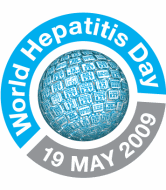The Importance of World Hepatitis Day
Interview with
Ben - World Hepatitis Day was a global event dreamed up by the World Hepatitis alliance, the WHA. In addition to the amazing events held at Birmingham University, the WHA sourced support from former US president, Bill Clinton, and London mayor Boris Johnson, who voiced his support through Twitter. Birmingham University's events saw researchers, students, members of parliament and patients and the media gather to hear about the importance of Hepatitis research. As well as exploring the latest scientific advances, we heard about the clinical implications and the opportunities for young doctors and PhD students. Dr Joe Grove organised the event and joined me afterwards to explain exactly what World Hepatitis Day is about.
 Joe - World Hepatitis Day, like World AIDS Day, has the general goal of raising awareness of viral hepatitis internationally. It's a little-known fact that one in twelve of the world's population are living with chronic hepatitis, caused by the hepatitis B virus or the hepatitis C virus, however, the vast majority of those individuals don't actually know they're infected. However if people seek out treatment, they may be able to have a resolution of their illness. So it's important that we raise awareness. And also people should be aware about how you can come into contact with these diseases and maybe change their lifestyle to avoid coming into contact.
Joe - World Hepatitis Day, like World AIDS Day, has the general goal of raising awareness of viral hepatitis internationally. It's a little-known fact that one in twelve of the world's population are living with chronic hepatitis, caused by the hepatitis B virus or the hepatitis C virus, however, the vast majority of those individuals don't actually know they're infected. However if people seek out treatment, they may be able to have a resolution of their illness. So it's important that we raise awareness. And also people should be aware about how you can come into contact with these diseases and maybe change their lifestyle to avoid coming into contact.
Ben - One in twelve people seems awfully high, I mean, that's hundreds of millions of people, surely?
Joe - Yeah, that's five hundred million (500,000,000) people worldwide. Obviously, like a lot of diseases, for instance like HIV, the distribution varies across the globe. In the case of hepatitis C virus, if you're looking at America, around 1-2% of the population; in the UK it's somewhere just below 1%; however if you maybe go to areas such as Egypt where, due to poor sterilisation during a vaccination campaign, you could look at a prevalence of 40-50% of the population in certain areas infected with Hepatitis C.
Ben - So what do people do to put themselves at risk of contracting Hepatitis?
Joe - Both hepatitis B and hepatitis C are predominately blood-borne infections, so you come into contact through blood to blood contact. So, for instance with hepatitis C, before there was a decent screening regime, the vast majority of infections in the West were due to blood transfusions. So people receiving blood transfusions before 1989 would possibly have come into contact with HCV [Hepatitis C Virus].  Now, in the developed world, such as the UK, the majority of new infections occur via intravenous drug users. However, it is also possible to catch the disease via sharing your toothbrush or razor or other drug paraphernalia with somebody who may be infected. hepatitis B on the other hand, you can also catch through those modes of transmission, however it is also quite easy to catch hepatitis B via unprotected sex. So there are numerous routes of transmission, not dissimilar to HIV.
Now, in the developed world, such as the UK, the majority of new infections occur via intravenous drug users. However, it is also possible to catch the disease via sharing your toothbrush or razor or other drug paraphernalia with somebody who may be infected. hepatitis B on the other hand, you can also catch through those modes of transmission, however it is also quite easy to catch hepatitis B via unprotected sex. So there are numerous routes of transmission, not dissimilar to HIV.
Ben - And what are you working on here in Birmingham?
Joe - So, specifically in Birmingham, we are looking at the way in which hepatitis C enters liver cells and we do this using the recently developed cell culture system. hepatitis C was discovered around 20 years ago and it has been only since about four years ago that we have been able to grow the virus in the lab. In having this full replication system, we can study the entry of the virus in cells. So we've been using different compounds and also looking at the effect of antibodies on whether or not the virus can infect cells. And also identifying and picking apart the receptors the virus uses to enter. Some of the most interesting work so far has been looking at the tricks that hepatitis C might use to evade the immune system. For instance, it's becoming apparent that HCV can pass from one cell directly to another, so from one infected cell to an uninfected cell, feasibly within the liver. The advantage to a virus of doing this is that it does not come into contact with circulating antibodies. Antibodies can stick to viruses and neutralise them, make them ineffectual. So by transmitting directly between cells, the virus avoids this.
Ben - Birmingham seems to be at the forefront of a lot of Hepatitis research, what's so special about Birmingham?
Joe - We're in a very fortunate position here to have some excellent scientists and clinicians and a leading liver unit that carries out hundreds of transplants a year for a lot of HCV and HBV [Hepatitis B Virus] patients. With severe disease, a transplantation's their only option. So, we have a lot of elements converging here in Birmingham, so it allows us to feed a basic scientific research into clinical results for patients. We also, here, have a dedicated clinical research facility.
Ben - And today's been a wonderful day to show it all off.
Joe - Yeah, it's been great. I think one of the moist valuable elements, really, is having representatives from the patient community come along. I think it's important that there's a communication between the different elements of viral hepatitis support throughout the UK so that we have the science going on, we have the clinical research and treatment; there's also groups doing social work for people infected with the HCV, like the Hepatitis C Trust. The work they do offers patient support. And obviously there's an increasingly large patient community. I think it's good to foster relationships between these, and today has been a great opportunity to do that.
Ben - That was Dr Joe Grove explaining why he thought a World Hepatitis Day event was important and why Birmingham University was ideally suited. As well as forging relationships between the diverse groups that were attending the event, Dr Grove took us on a tour of the labs, showing us both the scientific and clinical research settings. This was a great opportunity to really understand the research in its proper context and a view behind closed doors for the Hepatitis patients who had come along.










Comments
Add a comment